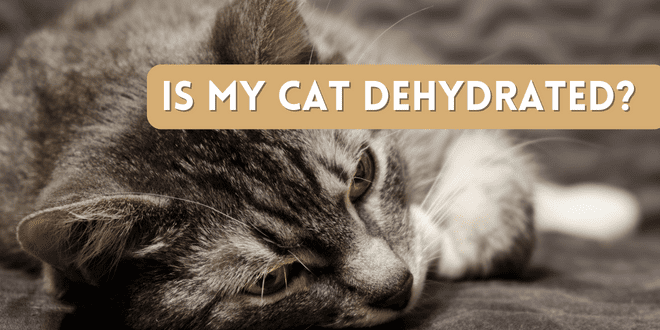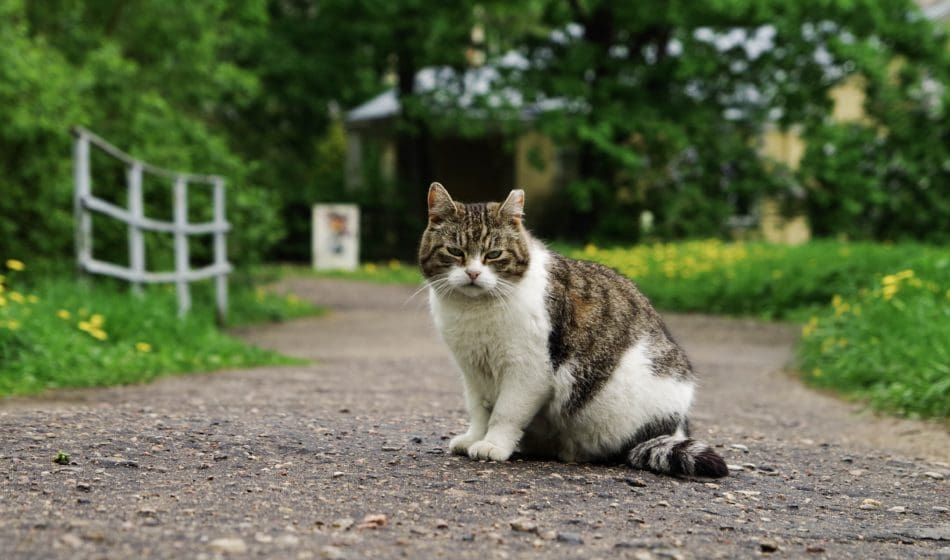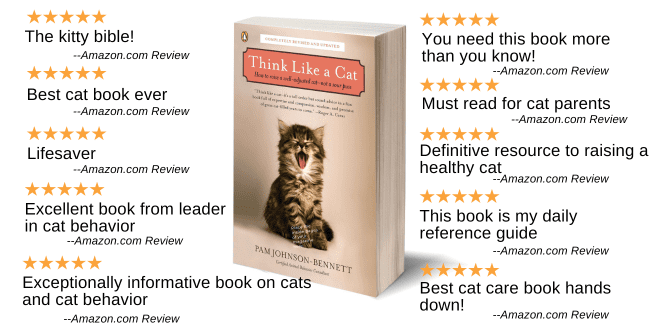
As you know, it’s crucial to stay on top of monitoring your cat’s health. As a responsible cat parent, you pay attention to your cat’s happiness, nutritional needs, litter box habits, behavior changes, and veterinary care.
One issue in cat healthcare that some cat parents may miss is dehydration. This can become a very serious issue with dangerous health complications if left untreated. It may even put your cat’s life at risk. If you monitor your cat’s water intake though, dehydration will be easier to detect and address.
Adequate water intake is important for cats. Just like us, cats need water for the body to properly function. Hydration is crucial to temperature regulation, muscle and tissue health, organ function, digestion, absorption of nutrients, and elimination of waste.
What is Dehydration?
Dehydration occurs when cats are losing more fluids than they are taking in. Dehydration causes a loss of electrolytes such as calcium, sodium, and potassium. Any cat can become dehydrated but the ones most vulnerable are kittens, older cats, and those with health issues.
Dehydration can be the result of conditions such as:
- Illness
- Getting overheated
- Fever
- Diarrhea
- Vomiting
- Metabolic disorders (such as kidney disease or diabetes)
- Lack of access to water
Symptoms of Dehydration in Cats
Recognizing the signs indicating a cat dehydrated is key to early treatment. Here are some common signs to watch for:
Dry gums and mouth. In a healthy, hydrated cat, the gums are pink, moist, and the mouth is wet. A dehydrated cat has pale, dry, tacky gums. The saliva will be thick and appear rope-like.
Sunken eyes. A dehydrated cat may have eyes that are sunken in or dull in appearance.
Loss of skin elasticity. A well-hydrated cat will have skin that when gently lifted, will quickly return to normal position when released.
Lethargy. A dehydrated cat often becomes lethargic and shows little interest in interacting with anything or anyone in their environment. This can be an easy one to miss because cats are known for sleeping quite a bit. A dehydrated cat will appear listless so it’s important to pay attention to the difference between your cat’s typical sleeping pattern and lethargy. More severe dehydration can lead to collapse.
Reduced urine output. Dehydration often results in less urination so your cat may visit the litter box less often than usual.
Loss of appetite. You may see your cat has little or no interest in food.
Panting. If dehydration is due to overheating, a cat may begin panting. A cat may also pant when stressed, in pain, or because of another health issue. Panting is not normal in cats and is an indication that something is wrong.
If you notice any of the above signs or suspect dehydration in your cat, it’s critical to get veterinary care immediately. If left untreated, dehydration can lead to serious health conditions.
How to Check for Dehydration
Check your cat’s gums. Lift the lip and look at your cat’s mouth. When properly hydrated, the gums should be wet, slippery, and pink. If they are dry or tacky, your cat is likely to be dehydrated. You can test for capillary refill time by gently pressing the gums with your finger. In a well-hydrated cat, a small white patch appears but then immediately disappears and the gum color springs back to pink. In a dehydrated cat, the gums remain white or take longer to return to a pink color after being pressed. Slow capillary refill time is an indication of dehydration.
Skin turgor test. You can do a skin pinch test by gently lifting the skin on the back of a cat’s neck, between the shoulder blades, and then releasing it. In a hydrated cat, the skin snaps back within a couple of seconds. If the cat is dehydrated, the skin will take more time to return to normal position or may remain in a tent position. This method is not as reliable in older cats though whose skin may no longer be as elastic due to age or chronic health issues.
Treatment for Dehydration
Let’s start with what NOT to do. Don’t force your cat to drink water or use a syringe or dropper to force water or wet food into your cat due to the very high risk of getting fluid into the lungs. Do not give milk to your cat as a replacement for water. Cats are lactose intolerant and drinking milk may result in diarrhea and vomiting, which can make dehydration worse.
Seek veterinary care. If you suspect your cat is dehydrated or your cat displays any of the above symptoms, it’s essential to have your veterinarian examine the cat. Your veterinarian will likely do blood and urine tests to ascertain the severity of the dehydration and identify possible underlying cause(s). In addition to any other treatments based on the underlying cause, the veterinarian may begin your cat on intravenous fluid therapy to quickly get your cat back to normal hydration levels. Fluid therapy consist of an electrolyte solution to restore balance. Mild dehydration may be treated with subcutaneous fluids (fluids given just under the skin).
Offer fresh water. Make sure your cat has access to fresh, clean water. Don’t use tap water. Offer spring or filtered water. Many cats don’t like the taste of tap water.
Wash the bowl out every day and refill with fresh water to prevent the build-up of biofilm.
Don’t place the water bowl too close to the food bowl. Many cats don’t want their water source near where they eat their prey. Slide the water bowl a little farther away from the food bowl; it can be in the same room, but just not right next to the food. Don’t use a double feeder bowl with water on one side and food on the other because food can spill over into the water and cause contamination or unpleasant taste, as well as discouraging a cat from drinking.
Try different water bowls. Your cat may not like drinking from a bowl that’s a particular shape or depth. Offer a few different types to see if your cat has a preference. If you currently have a deep bowl, try a shallower saucer in case your cat doesn’t like having his whiskers squished. Some cats like drinking from cups and they prefer to dip their paws in and then lick the liquid from them. Be creative and offer various options to pinpoint any likes or dislikes.
Don’t use plastic bowls. Many cats have a negative reaction to plastic in the form of feline acne. Don’t use plastic for food or water. Plastic tends to retain odors and any scratches in the bowl can also harbor bacteria. Stick to glass, stainless steel, or ceramic.
Elevating the water bowl may help. For older cats who may have arthritis, it may be more comfortable to drink (and eat) from an elevated bowl. You can find these bowls at your local pet supply store and online.
Provide water in multiple locations. This is especially important in multicat households or if your cat has any mobility issues. Don’t locate bowls in noisy areas or where there’s a lot of household traffic.
Many cats don’t like to the presence of food near their water source so provide additional water in several areas of the home, away from the feeding station.
Don’t put water bowls near litter boxes. Cats don’t tend to like water sources near elimination areas.
Pay attention to any mobility issues in your cat that might make it difficult to access to the water bowl. Provide water in areas where your cat frequents so he doesn’t have too far to walk when thirsty.
Switch to wet food. If you feed wet food to your cat, it has a higher moisture content (about 70-80%), but if you feed only dry food (about 10% moisture), they might not be getting an adequate amount to stay properly hydrated. A transition to wet food helps increase hydration and the cat doesn’t need to drink as much from the water bowl. If you have questions about what you feed your cat, consult with your veterinarian. Generally, if your cat is prone to dehydration, your veterinarian will recommend a transition to wet food. If your cat remains on dry food, then all the water requirements will have to come from the water bowl.
If your cat is already on wet food and is dehydrated, your veterinarian may recommend mixing additional water into the food.
If your cat won’t eat wet food, try mixing a little in with the dry food and you can hopefully do a gradual transition as your cat adjusts. If all else fails, try adding water to the dry food. Add a little at a time to make the adjustment easier because you don’t want your cat to end up rejecting the food completely.
Besides having a higher moisture content, another benefit of feeding wet food is that it’s higher in protein and lower in carbohydrates.
Try a pet water fountain. Your cat may prefer drinking from a fountain because the flowing water tastes fresher. If you do decide to use a water fountain for your cat, follow the cleaning instructions carefully because fountains do require regular maintenance to keep them clean, including the filter.
Add a little flavor. A little low-sodium or sodium-free chicken broth or tuna water (from tuna packed in water) added into the water can sometimes entice a cat to drink a little more. If you decide to do this, offer a bowl of plain water as well so your cat has the choice.
In warm weather, put the chicken broth or tuna water into ice cube trays, freeze, and then drop a cube into the water bowl as a refreshing treat. This may be a way to entice your cat to drink as he plays with the moving ice cube in the bowl.
Always check with your veterinarian first though before putting any additive into your cat’s water.
Don’t Forget Outdoor Cats
If you allow your cat outdoors, or your cat is exclusively outdoors, provide fresh water sources. In warm weather, locate water in shaded areas and replenish bowls with fresh water regularly. Add ice cubes to the bowl to cool the water, if needed. Make sure outdoor cats have access to shady areas to rest to avoid becoming overheated. In very hot weather, don’t let your cat indoor/outdoor cat outside in the middle of the day when it’s at its hottest.
In cold weather, provide water sources that don’t freeze for outdoor cats.

Photo: Pille Kirsi on Pexels
Monitor Your Cat’s Water Intake
Be consistent in how much you fill the water bowls each day to get a better idea of how much is being consumed. You may even use a bowl with measuring lines to help you keep track.
Pay attention to your cat’s hydration because it’s vital to good health. Learn to recognize early signs of dehydration so if it does happen, you are able to intervene quickly to increase the chances of a rapid recovery. Even if your cat eats moist food, always supply fresh, clean water in multiple locations and monitor your cat for any changes in behavior, appetite, or appearance. Seek veterinary care immediately if have any concerns about your cat’s health or hydration level. Your veterinarian can guide you on how much water your cat should be drinking based on age, health, activity, and nutritional program.
Your attentiveness will help ensure your cat stays happy and hydrated.
Need More Information?
If you have concerns or questions about whether your cat is dehydrated, or any aspect of your cat’s health, consult your veterinarian. This article is not intended to diagnose nor is it a replacement for your cat’s individual veterinary care.
For information on cat behavior and training, check out the best-selling books by Pam Johnson-Bennett. Pam’s books are available at book stores as well as online. We’ve included Amazon associate links here on our website.
 Problem Solving & Advice by Pam Johnson-Bennett Cat Behavior Expert & Best-selling Author
Problem Solving & Advice by Pam Johnson-Bennett Cat Behavior Expert & Best-selling Author




